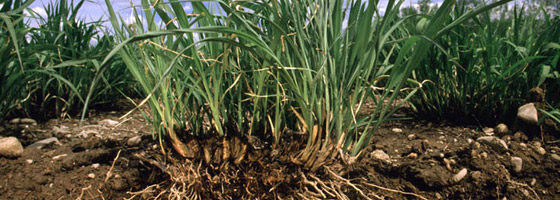The Nitrogen Cycle

Nitrogen is essential to life because it is a key component of proteins and nucleic acids. Nitrogen occurs in many forms and is continuously cycled among these forms by a variety of bacteria. Although nitrogen is abundant in the atmosphere as diatomic nitrogen gas (N2), it is extremely stable, and conversion to other forms requires a great deal of energy. Historically, the biologically available forms NO3- and NH3 have often been limited; however, current anthropogenic processes, such as fertilizer production, have greatly increased the availability of nitrogen to living organisms. The cycling of nitrogen among its many forms is a complex process that involves numerous types of bacteria and environmental conditions.
In general, the nitrogen cycle has five steps:
- Nitrogen fixation (N2 to NH3/ NH4+ or NO3-)
- Nitrification (NH3 to NO3-)
- Assimilation (Incorporation of NH3 and NO3- into biological tissues)
- Ammonification (organic nitrogen compounds to NH3)
- Denitrification(NO3- to N2)
Nitrogen Fixation
Nitrogen fixation is the process by which gaseous nitrogen (N2) is converted to ammonia (NH3 or NH4+) via biological fixation or nitrate (NO3-) through high-energy physical processes. N2 is extremely stable and a great deal of energy is required to break the bonds that join the two N atoms. N2 can be converted directly into NO3- through processes that exert a tremendous amount of heat, pressure, and energy. Such processes include combustion, volcanic action, lightning discharges, and industrial means. However, a greater amount of biologically available nitrogen is naturally generated via the biological conversion of N2 to NH3/ NH4+. A small group of bacteria and cyanobacteria are capable using the enzyme nitrogenase to break the bonds among the molecular nitrogen and combine it with hydrogen.
Nitrogenase only functions in the absence of oxygen. The exclusion of oxygen is accomplished by many means. Some bacteria live beneath layers of oxygen-excluding slime on the roots of certain plants. The most important soil dwelling bacteria, Rhizobium, live in oxygen-free zones in nodules on the roots of legumes and some other woody plants. Aquatic filamentous cyanobacteria utilize oxygen-excluding cells called heterocysts.
Nitrification
Nitrification is a two-step process in which NH3/ NH4+ is converted to NO3-. First, the soil bacteria Nitrosomonas and Nitrococcus convert NH3 to NO2-, and then another soil bacterium, Nitrobacter, oxidizes NO2- to NO3-. These bacteria gain energy through these conversions, both of which require oxygen to occur.
Assimilation
Assimilation is the process by which plants and animals incorporate the NO3- and ammonia formed through nitrogen fixation and nitrification. Plants take up these forms of nitrogen through their roots, and incorporate them into plant proteins and nucleic acids. Animals are then able to utilize nitrogen from the plant tissues.
Ammonification
Assimilation produces large quantities of organic nitrogen, including proteins, amino acids, and nucleic acids. Ammonification is the conversion of organic nitrogen into ammonia. The ammonia produced by this process is excreted into the environment and is then available for either nitrification or assimilation.
Denitrification
Denitrification is the reduction of NO3- to gaseous N2 by anaerobic bacteria. This process only occurs where there is little to no oxygen, such as deep in the soil near the water table. Hence, areas such as wetlands provide a valuable place for reducing excess nitrogen levels via denitrification processes.
Common Forms of Nitrogen
The most common forms of inorganic nitrogen in the environment are diatomic nitrogen gas (N2), nitrate (NO3-), nitrite (NO2-), ammonia (NH3), and ammonium (NH4+). The species that predominate depend on the chemical, physical, and biological environment.
In aquatic environments, the presence of nitrogen as unionized ammonia (NH3) or ammonium (NH4+) is dependent on the pH and temperature.
When the pH is below 8.75, NH4+ predominates. Increases in pH signify increases in the hydroxyl ion (OH-) concentration of the water, meaning the above reaction will shift to the left in order to reach equilibrium. Above a pH of 9.75, NH3 predominates (Hem, 1985). NH3 is a more toxic to aquatic life. If biological assimilation of NH3 is not occurring at a sufficient rate, NH3 may accumulate and cause detrimental effects to aquatic life.
In soils, NH4+ ions are strongly sorbed by clay particles and organic matter, which have a net negative surface charge. In alkaline soils, NH4+ will be converted to NH3 gas, and lost to the atmosphere. Under warm growing conditions, NH4+ in the soil will be transformed to NO3- via nitrification. NO3- is very soluble, and can easily be leached from soils under wet conditions.
Nitrogen Monitoring
Monitoring nitrogen levels is necessary for many reasons, including detecting baseline nutrient levels and trends, preventing eutrophication, maximizing soil productivity, and minimizing toxic effects of ammonia or nitrite poisoning.
References:
- Hem, J.D. 1985. Study and Interpretation of the Chemical Characteristics of Natural Water. Washington, D.C., USGS Water-Supply Paper 2254
- Raven, P.H., Evert, R.F., and Eichhorn, S.E. 1992. Biology of Plants. Fifth edition. Worth Publishers, New York, New York. pp. 602-611.
Image Credit: USDA.gov, Wikipedia





Sher waheed
October 3, 2015 at 7:18 am
Good! definations!
jamie
April 21, 2020 at 10:32 am
Omg thank you,My students needed this
Pingback: Nitrogen related common terms with definitions
Pingback: How does a Forest Ecosystem Work(Part Two- Replenishment and Retention of Nutrients and methods to replicate them) – MINeD
Pingback: Nitrogen in viticulture and winemaking: an exploration from soil to bottle
Drevan
March 26, 2024 at 3:37 pm
This is some good information thank you very much